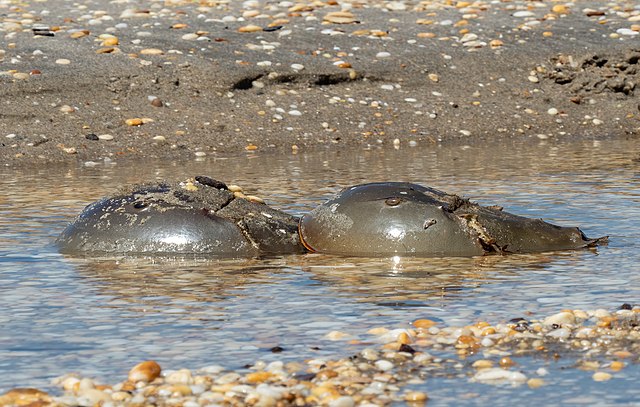Horseshoe crabs might finally get their big break after surviving millennia of mass extinctions. On February 12, environmental lobbies petitioned the National Oceanic and Atmospheric Administration (NOAA) in Washington D.C. to list the crustaceans as “living fossils.”
The “living fossil” attribute by the lobby groups fits the creatures as they have probably existed for 445 million years. Their main habitat are the brackish waters of the East Coast of the United States, especially the Delaware Estuary.
In lodging the petition, the Center for Biological Diversity and other environmentalists want NOAA to treat horseshoe crabs as endangered wildlife.
The groups want fishermen not to cast them as baits nor for researchers to use their blue blood in vaccine safety tests.
A successful listing could benefit red knot birds that fly 9300 miles between South America and the northern Polar regions. Since the 1980s, these birds have been finding lesser horseshoe crab eggs as their stopover repast in Delaware Bay.
The population of red knots took a hit between 1981 and 2021, when numbers shrunk by 75%. Researches believe this is due to a decline in horseshoe crab eggs, which are their refuelling diet during exhausting travel.
Decline and Ban
In the 1990s, the horseshoe crab population took a sharp decline as fishermen overused them as eel bait.
More so, a million specimen get into an American medical lab annually, where scientists draw 30% of their blue blood. And even if they get back into the ocean alive, at least 15% of them die out.
In mitigation, in August 2023 the U.S. Fish and Wildlife Service banned fishing in a South Carolina reserve during reproduction. The period under the ban extends from mid-March to mid-July each year, henceforth.
The current petition to NOAA, however, wants to include the entire East Coast, especially the intense New England fishing area.
Price of Horseshoe Crabs
As environmentalists know, the crabs are fast becoming endangered due to appetite for their blue blood in the biomedical industry.
Since a finding in the 1960s that horseshoe crab blood could test for microscopic contaminants in vaccines, the serum has turned gold. A gallon or 3.79 kilograms of the blood sells for $60,000.
Yet, fishermen who mostly use the crustaceans for attracting eels only sell each live creature for $8 to $12. Adults weigh about 4 kg, vis-á-vis other edible U.S. crabs, which often reach $17.50 a pound.
This kind of exploitation is what has necessitated the calling for an endangered species act to save them.
